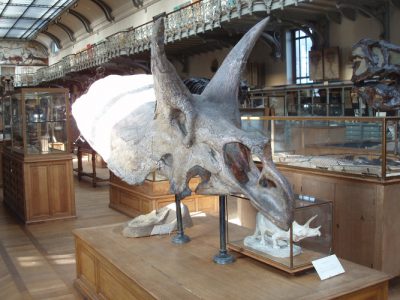The species for the palaeontologist
PDFPaleontology does not have access to the same information as biology to identify and differentiate species. Fossils, whether they consist of intact remains of hard parts (shells, etc.), their molding in sediments, or very exceptionally footprints or soft tissue molds, no longer contain identifiable or sufficiently preserved DNA molecules to be informative. The definition of a fossil species is therefore based only on the morphology of the remains found (although this morphology is nowadays analysed in detail using software, virtually reconstructed in three dimensions and compared to others using sophisticated statistical tools).

- Overestimation: current morphologically distinct organisms are still genetically close enough to hybridize: this is the case for polar and grizzly bears, which are nevertheless two morphological species. In the case of fossils, organisms of the same species but at different stages of growth may differ sufficiently to be described as different species: the case has been proposed, inter alia, for some late Cretaceous dinosaurs found in Wyoming, North America: the different species defined in the genus Triceratops (Figure 1) would actually represent only one; worse still, the fossils attributed to the neighbouring genus Torosaurus would also be Triceratops. In these animals, the shape of the skull, the size and orientation of the horns, the ornamentation of their collar, etc. changed significantly during growth, giving distinctly different morphologies.
- Underestimation: organisms of almost identical morphologies may have a very clear genetic divergence: biologists refer to them as cryptic species complexes). Morphologically, the paleontologist will only see one species.
In reality, paleontology will always underestimate paleo-biodiversity, since it is likely that some species are not represented at all in the fossil record; but biologists also have only estimates of current biodiversity.
In addition, the paleontologist cannot generally count all the species that coexisted at a very specific time in the past, but only those that they encounter in the same sedimentary layers corresponding to a certain time interval (100,000 years or 1 million years, for example). Comparing directly the biodiversity inventoried by scientific ecology and the palaeo-biodiversity indexed by palaeontology is therefore not very meaningful.
Paleontologists attempting to estimate this paleo-biodiversity are therefore more interested in its variations over geological time than in its absolute value at any given time. They also take into account the problems that can artificially bias their fossil species count (period of poor fossilization, fossil quality, different collection and study efforts according to the groups of organisms considered [1], etc.). It is only once these sources of error have been taken into account that they can search for ecological causes of fluctuations in palaeo-biodiversity.
References and notes
[1] Some groups of organisms are much less frequent than others in fossil collections, or less studied and by fewer researchers, so necessarily less well known: while there is no shortage of dinosaur specialists, microarthropod experts are much rarer…




